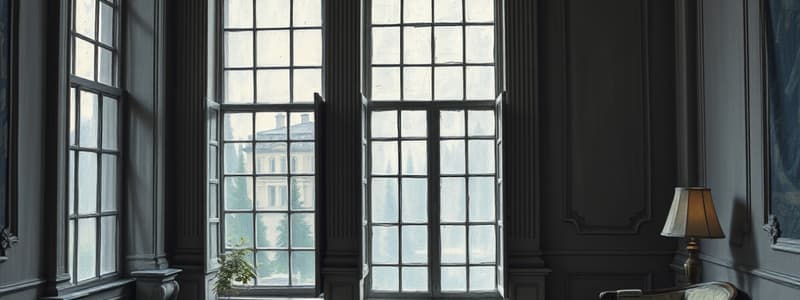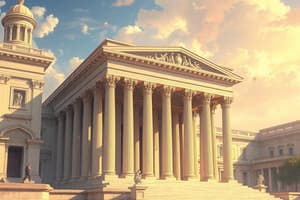Podcast
Questions and Answers
What is a Palladian window?
What is a Palladian window?
- A window with three openings including a larger arched central window (correct)
- A traditional English casement window
- A modern sliding glass door
- A window designed in the Victorian style
What are sash windows characterized by?
What are sash windows characterized by?
Vertically sliding panels (sashes) each containing glass panes
What is a slipper foot?
What is a slipper foot?
A carved chair or table leg with a foot that ends in a flat, pad-like foot
Describe a sabre leg.
Describe a sabre leg.
What does a ball and claw foot resemble?
What does a ball and claw foot resemble?
What is the Empire waist in clothing?
What is the Empire waist in clothing?
What were sans culottes?
What were sans culottes?
What is a bicorn?
What is a bicorn?
What is a cockade?
What is a cockade?
What does the term indispensable refer to in the Empire period?
What does the term indispensable refer to in the Empire period?
Flashcards are hidden until you start studying
Study Notes
Neoclassical Architectural Elements
- Palladian Window: Characterized by three openings with a large arched central window flanked by smaller rectangular ones. Often incorporates pilasters or columns for support and can function as a French window/door, keeping the semicircular light fixed.
- Sash Window: Originated in 17th century England, this vertically sliding window design became a hallmark of Neoclassical and contemporary architecture, particularly in English and American styles. It replaced hinged casement windows, featuring single or double-hung variants.
Neoclassical Furniture Design
- Slipper Foot: A distinctive feature of furniture, this is a carved leg ending in a flat, pad-like foot atop a cabriole leg.
- Sabre Leg: Recognized in Empire chairs, these rear legs curve outward and backward, reminiscent of ancient Greek chairs.
- Ball and Claw Foot: A decorative element found on cabriole legs resembling a ball grasped by a claw, adding character to furniture pieces.
Neoclassical Fashion and Accessories
- Empire Waist: The fashion style characterized by a high gathering of fabric just below the bust, a signature element of Directoire and Empire dresses.
- Sans Culottes: Loose trousers worn by men as a statement of solidarity with French revolutionaries, contrasting aristocratic knee breeches.
- Bicorn: A prominent hat style of the Revolutionary and Empire periods, featuring two sides raised and pinned with a cockade; famously worn by Napoleon.
- Cockade: A decorative ribbon, typically in red, white, and blue, worn on hats or bonnets as a symbol of support for the Revolution.
- Indispensable: Refers to a small handbag popular among women during the Empire period, designed to dangle from the wrist, combining practicality with style.
Studying That Suits You
Use AI to generate personalized quizzes and flashcards to suit your learning preferences.





